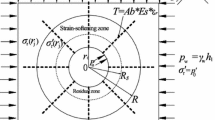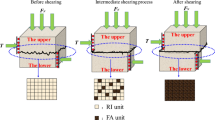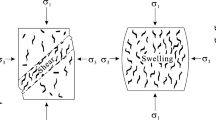Abstract
Large deformation phenomena in rock engineering are commonly key bottlenecks impeding engineering progress. Correspondingly, large deformation analysis in rock mechanics has a widespread impact on mechanism understanding, prevention, and control guidance. Various large deformation schemes broadly categorized as hypoelastic- and hyperelastic-based models exist in the literature and software. Without an understanding of the capabilities and demerits of these schemes, the diversity in choices inadvertently leads to pitfalls, placing engineering endeavors at a disadvantage. In this work, we review and compare the most prevalent schemes (including PK2-Green, Jaumann, Green–Naghdi, Truesdell, and hyperelastic-based schemes) from perspective of rock mechanics, with an emphasis on their application in rock engineering, and further develop a hyperelastic-based large deformation scheme (marked as Cauchy-Ln scheme) based on Cauchy stress and Hencky logarithm strain. The proposed model realizes the separation of material nonlinearity and geometry nonlinearity. Several typical large deformation phenomena in rock engineering are studied. The relationships between large deformation phenomena and large deformation analyses are clarified under different circumstances. Especially under large strain conditions, the PK2-Green scheme is enfeebled, and the hypoelastic-based scheme should be used with caution. For rock material with an apparent pressure-sensitive effect, the proposed Cauchy-Ln scheme is superior.
Highlights
-
The connections between large deformation phenomenon and large deformation analysis are delineated.
-
Prevalent large deformation schemes are compared from a rock mechanics perspective with an emphasis on application in rock engineering.
-
A newly hyperelastic-based large deformation numerical model, enhancing compatibility with rocks, is developed.


















Similar content being viewed by others
Data availability
All data and codes are available from the corresponding author upon reasonable request.
Abbreviations
- \({\mathbb{a}}\) :
-
Spatial tangent modulus
- \({\varvec{b}}^{{\text{e}}}\) :
-
Elastic left Cauchy–Green deformation tensor
- \({\varvec{b}}\) :
-
Body force
- \( {\mathbb{D}}^{{\text{e}}}\) :
-
Linear isotropic elasticity tensor
- \( {\mathbb{D}}^{{{\text{ep}}}}\) :
-
Elastoplastic tangent modulus
- \({\varvec{d}}\) :
-
Rate of deformation tensor
- \( {\varvec{d}}^{{\text{e}}}\) :
-
Rate of elastic deformation tensor
- \( {\varvec{d}}^{{\text{p}}}\) :
-
Rate of plastic deformation tensor
- \(E\) :
-
Young’s modulus
- \({\varvec{E}}\) :
-
Green strain tensor
- \({\varvec{e}}\) :
-
Eulerian Hencky strain tensor
- \({\varvec{F}}\) :
-
Deformation gradient tensor
- \({\varvec{I}}\) :
-
Second-order identity tensor
- \(J\) :
-
Jacobian of the deformation gradient
- \({\varvec{l}}\) :
-
Velocity gradient tensor
- \({\varvec{P}}\) :
-
First Piola–Kirchhoff stress tensor
- \(q\) :
-
Hardening force
- \({\varvec{R}}\) :
-
Rotation tensor
- \({\varvec{S}}\) :
-
Second Piola–Kirchhoff stress tensor
- \({\varvec{t}}\) :
-
Surface traction vector
- \({\varvec{U}}\) :
-
Right stretch tensor
- \({\varvec{u}}\) :
-
Displacement vector
- \({\varvec{V}}\) :
-
Left stretch tensor
- \({\varvec{w}}\) :
-
Spin tensor
- x :
-
Position vector in current configuration
- X :
-
Position vector in initial configuration
- \(\gamma\) :
-
Plastic multiplier
- \({\varvec{\varepsilon}}\) :
-
Infinitesimal strain tensor
- \( {\varvec{\varepsilon}}^{{\text{e}}}\) :
-
Elastic strain tensor
- \( {\varvec{\varepsilon}}^{{\text{p}}}\) :
-
Plastic strain tensor
- \( \overline{\varepsilon }^{{\text{p}}}\) :
-
Effective plastic strain
- \(\theta\) :
-
Frictional angle
- \(\vartheta\) :
-
Dilatancy angle
- \(\nu\) :
-
Poisson’s ratio
- \({\varvec{\sigma}}\) :
-
Cauchy stress tensor
- \({\varvec{\sigma}}^{\nabla }\) :
-
The specific stress rate of Cauchy stress
- \({\varvec{\tau}}\) :
-
Kirchhoff stress tensor
- \(\psi\) :
-
Strain density per unit reference volume
- \({\Phi }\) :
-
Yield function
- \({\Psi }\) :
-
Flow potential
- \({\varvec{\varOmega}}\) :
-
Angular velocity tensor
References
Abe Y, Yamada S, Hoshi K, Kyoya T (2024) Reconstruction of Cam–Clay model based on multiplicative decomposition of the deformation gradient. Comput Geotech 166:105958
Barla G, Bonini M, Semeraro M (2011) Analysis of the behaviour of a yield-control support system in squeezing rock. Tunn Undergr Space Technol 26(1):146–154
Bathe K, Ramm E, Wilson EL (1975) Finite element formulations for large deformation dynamic analysis. Int J Numer Meth Eng 9(2):353–386
Belytschko T, Liu WK, Moran B, Elkhodary K (2013) Nonlinear finite elements for continua and structures. Wiley, Hoboken
Bennett KC, Regueiro RA, Borja RI (2016) Finite strain elastoplasticity considering the Eshelby stress for materials undergoing plastic volume change. Int J Plast 77:214–245
Bennett KC, Regueiro RA, Luscher DJ (2019) Anisotropic finite hyper-elastoplasticity of geomaterials with Drucker-Prager/cap type constitutive model formulation. Int J Plast 123:224–250
Cabezas EE, Celentano DJ (2004) Experimental and numerical analysis of the tensile test using sheet specimens. Finite Elem Anal Des 40(5):555–575
Cavers DS (1981) Simple methods to analyze buckling of rock slopes. Rock Mech 14(2):87–104
Chen WF (1975) Limit analysis and soil plasticity. Elsevier, Amsterdam
Chen Z, He C, Xu G, Ma G, Wu D (2019) A case study on the asymmetric deformation characteristics and mechanical behavior of deep-buried tunnel in phyllite. Rock Mech Rock Eng 52(11):4527–4545
Cheng X, Tang C, Zhuang D (2022) A finite-strain viscoelastic-damage numerical model for time-dependent failure and instability of rocks. Comput Geotech 143:104596
Eterovic AL, Bathe K (1990) A hyperelastic-based large strain elasto-plastic constitutive formulation with combined isotropic-kinematic hardening using the logarithmic stress and strain measures. Int J Numer Meth Eng 30(6):1099–1114
Gadala MS, Wang J (2000) Computational implementation of stress integration in Fe analysis of elasto-plastic large deformation problems. Finite Elem Anal Des 35(4):379–396
Ghasemi M, Corkum AG, Gorrell GA (2021) Ground surface rock buckling: analysis of collected cases and failure mechanisms. Bull Eng Geol Environ 80(6):4255–4276
Green AE, Naghdi PM (1971) Some remarks on elastic-plastic deformation at finite strain. Int J Eng Sci 9(12):1219–1229
Guan K, Zhu W, Wei J, Liu X, Niu L, Wang X (2018) A finite strain numerical procedure for a circular tunnel in strain-softening rock mass with large deformation. Int J Rock Mech Min 112:266–280
Guo H, Chen X, He M, Xi S, Tang J (2010) Frictional contact algorithm study on the numerical simulation of large deformations in deep soft rock tunnels. Min Sci Technol (china) 20(4):524–529
Hashiguchi K (2019) Multiplicative hyperelastic-based plasticity for finite elastoplastic deformation/sliding: a comprehensive review. Arch Comput Method E 26(3):597–637
He M, Gong W, Wang J et al (2014) Development of a novel energy-absorbing bolt with extraordinarily large elongation and constant resistance. Int J Rock Mech Min 67:29–42
Ji W, Waas AM, Bazant ZP (2013) On the importance of work-conjugacy and objective stress rates in finite deformation incremental finite element analysis. J Appl Mech. https://doi.org/10.1115/1.4007828
Jing L (2003) A review of techniques, advances and outstanding issues in numerical modelling for rock mechanics and rock engineering. Int J Rock Mech Min 40(3):283–353
Kazakidis VN (2002) Confinement effects and energy balance analyses for buckling failure under eccentric loading conditions. Rock Mech Rock Eng 35(2):115–126
Kojić M, Bathe K (1987) Studies of finite element procedures—stress solution of a closed elastic strain path with stretching and shearing using the updated Lagrangian Jaumann formulation. Comput Struct 26(1):175–179
Korobeynikov SN (2023) Families of hooke-like isotropic hyperelastic material models and their rate formulations. Arch Appl Mech 93(10):3863–3893
Le Pense S, Arson C, Pouya A (2016) A fully coupled damage-plasticity model for unsaturated geomaterials accounting for the ductile-brittle transition in drying clayey soils. Int J Solids Struct 91:102–114
Li Z, Lv Q, Zhu H, Hu J, Feng J, He M (2019) Laboratory testing and modeling of a high-displacement cable bolt. Int J Geomech 19(7):4019078
Li G, Cheng X, Hu L, Tang C (2021) The material-structure duality of rock mass: insight from numerical modeling. Int J Rock Mech Min 144:104821
Liu C, Hong H (1999) Non-oscillation criteria for hypoelastic models under simple shear deformation. J Elasticity 57(3):201–241
Longère P (2019) Numerical integration of rate constitutive equations in presence of large strains and rotations. Mech Res Commun 95:61–66
Meng L, Li T, Jiang Y, Wang R, Li Y (2013) Characteristics and mechanisms of large deformation in the Zhegu mountain tunnel on the Sichuan-Tibet Highway. Tunn Undergr Space Technol 37:157–164
Meschke G, Liu WN (1999) A re-formulation of the exponential algorithm for finite strain plasticity in terms of Cauchy stresses. Comput Method Appl M 173(1):167–187
Montáns FJ, Bathe K (2005) Computational issues in large strain elasto-plasticity: an algorithm for mixed hardening and plastic spin. Int J Numer Methods Eng 63(2):159–196
Okazawa S (2010) Structural bifurcation for ductile necking localization. Int J Nonlinear Mech 45(1):35–41
Ortlepp WD (2001) The behaviour of tunnels at great depth under large static and dynamic pressures. Tunn Undergr Space Technol 16(1):41–48
Perić D, Owen DRJ, Honnor ME (1992) A model for finite strain elasto-plasticity based on logarithmic strains: computational issues. Comput Methods Appl Mech Eng 94(1):35–61
Rosales Garzon SE (2016) Analytical solution for assessing continuum buckling in sedimentary rock slopes based on the tangent-modulus theory. Int J Rock Mech Min 90:53–61
Simo JC (1992) Algorithms for static and dynamic multiplicative plasticity that preserve the classical return mapping schemes of the infinitesimal theory. Comput Methods Appl Mech Eng 99(1):61–112
Simo JC, Armero F (1992) Geometrically non-linear enhanced strain mixed methods and the method of incompatible modes. Int J Numer Methods Eng 33(7):1413–1449
Vrakas A, Anagnostou G (2014) A finite strain closed-form solution for the elastoplastic ground response curve in tunnelling. Int J Numer Anal Methods Geomech 38(11):1131–1148
Vrakas A, Anagnostou G (2015) A simple equation for obtaining finite strain solutions from small strain analyses of tunnels with very large convergences. Géotechnique 65(11):936–944
Wang M, Zhang N, Li J, Ma L, Fan P (2015) Computational method of large deformation and its application in deep mining tunnel. Tunn Undergr Space Technol 50:47–53
Wang M, Li S, Yuan C et al (2021) A manifold Lagrangian integration point method for large deformation failure modelling of rock slopes. Comput Geotech 129:103875
Xu C, Xia C (2021) A new large strain approach for predicting tunnel deformation in strain-softening rock mass based on the generalized Zhang-Zhu strength criterion. Int J Rock Mech Min 143:104786
Xu C, Xia C, Han C (2021) Modified ground response curve (GRC) in strain-softening rock mass based on the generalized Zhang-Zhu strength criterion considering over-excavation. Undergr Space 6(5):585–602
Yamakawa Y (2022) Hyperelastic constitutive models for geomaterials: extension of existing models to include finite strains and their comparison. Comput Geotech 143:104600
Yuan W, Wang H, Zhang W, Dai B, Liu K, Wang Y (2021) Particle finite element method implementation for large deformation analysis using Abaqus. Acta Geotech 16(8):2449–2462
Zhang Q, Wang H, Jiang Y, Lu M, Jiang B (2019) A numerical large strain solution for circular tunnels excavated in strain-softening rock masses. Comput Geotech 114:103142
Zhang Q, Wang X, Jiang B, Liu R, Li G (2021) A finite strain solution for strain-softening rock mass around circular roadways. Tunn Undergr Space Technol 111:103873
Zhao Y, Feng X, Jiang Q et al (2021) Large deformation control of deep roadways in fractured hard rock based on cracking-restraint method. Rock Mech Rock Eng 54(5):2559–2580
Zhao R, Li C, Zhou L, Zheng H (2022) A sequential linear complementarity problem for multisurface plasticity. Appl Math Model 103:557–579
Acknowledgements
The authors would like to express their gratitude to the two anonymous reviewers and editors for their meticulous, professional, and insightful comments.
Funding
This work is supported in part by GHfund A (2023020122702), the China Postdoctoral Science Foundation (2023TQ0025), the Chinese Universities Scientific Fund (Z1090124057), and the National Natural Science Foundation of China (42050201, 41941018).
Author information
Authors and Affiliations
Corresponding author
Ethics declarations
Conflict of interest
The authors declare they have no conflicts of interest to this work.
Additional information
Publisher's Note
Springer Nature remains neutral with regard to jurisdictional claims in published maps and institutional affiliations.
Rights and permissions
Springer Nature or its licensor (e.g. a society or other partner) holds exclusive rights to this article under a publishing agreement with the author(s) or other rightsholder(s); author self-archiving of the accepted manuscript version of this article is solely governed by the terms of such publishing agreement and applicable law.
About this article
Cite this article
Cheng, X., Tang, C. & Feng, X. When Large Deformation Analysis Meets Large Deformation Phenomenon: Comparative Study and Improvement. Rock Mech Rock Eng (2024). https://doi.org/10.1007/s00603-024-03912-8
Received:
Accepted:
Published:
DOI: https://doi.org/10.1007/s00603-024-03912-8




